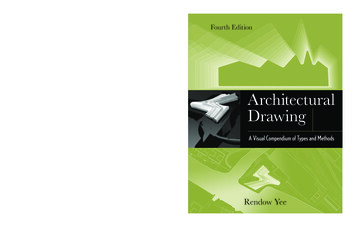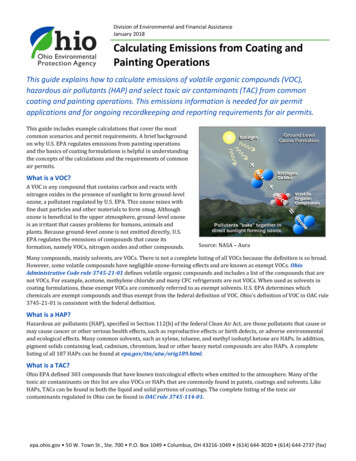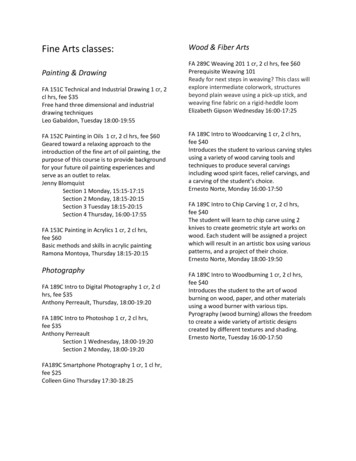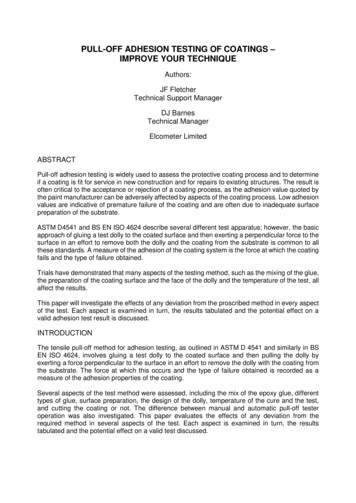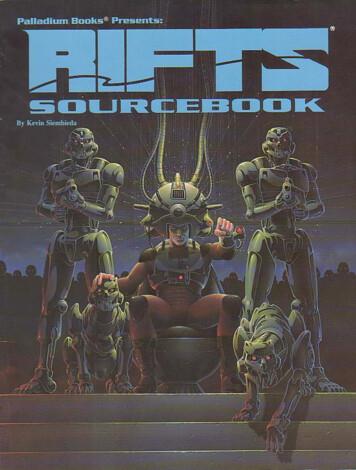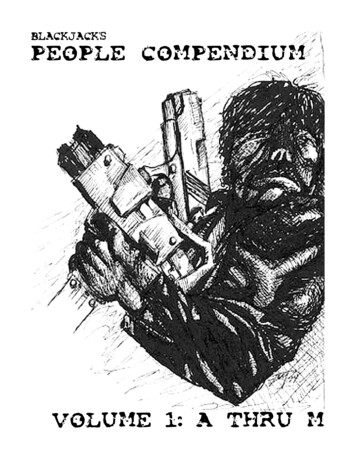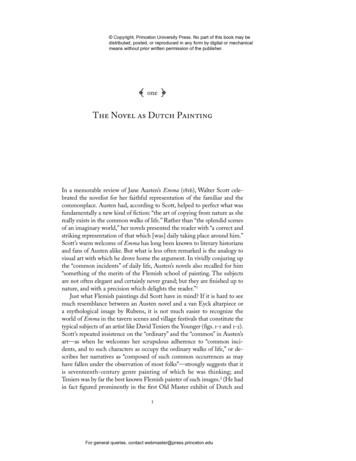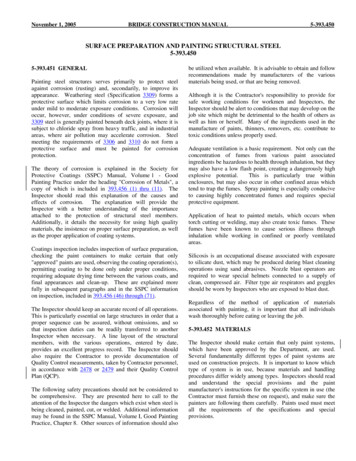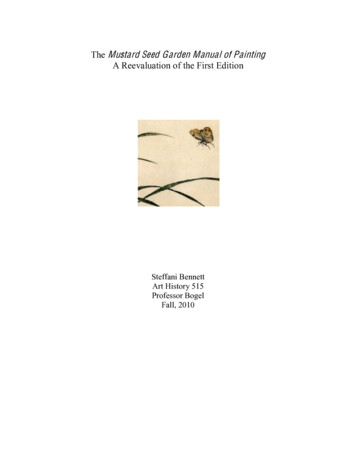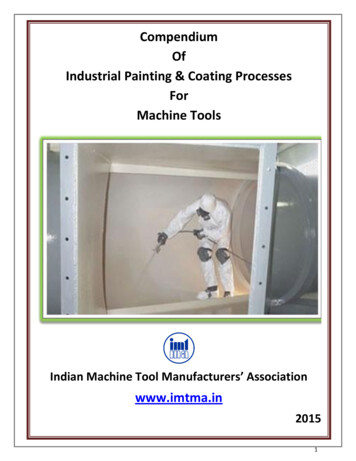
Transcription
CompendiumOfIndustrial Painting & Coating ProcessesForMachine ToolsIndian Machine Tool Manufacturers’ Associationwww.imtma.in20151
ContentsForeword1.Basics of Paint on Machine Tool2.Industrial Painting and Coating3.Surface Preparation – A guide for the users4.Coating Application Types and Technologies5.Comparison of Coatings6.Paint Trouble Shooting – Paint Problems and Solutions7.Pollution Prevention for the Coating Industry8.Proper Coating Techniques for Operators9.Inspection of Paints/QP for PaintingAnnexuresAnnexure 1List of Indian Standard for painting procedure forMachine Tools & other related standardsAnnexure 2Overview of Paint shops in some of the reputeMachine Tool IndustriesAnnexure 3List of paint testing equipmentAcknowledgementReferences/Sources2
ForewordIMTMA is bringing out the 1st edition of “Guide Book on Industrial Painting & Coating Processes forMachine Tools” to strengthen the supply chain for the benefit of the Indian Machine Tool Industry.This reference book will lay down the basics of paint applications, coating types and technologies,common paint problems with possible solutions relevant to the machine tool industryThe content of the manual is described from various related websites, manufacturers’ guidelinesand machine tool builders’ feedback. Important topics are discussed and focused in order toenlighten the knowledge of industrial paints and coating processes.Every effort has been made to make this handbook as ‘complete and accurate as possible’.Nevertheless, it is likely that some aspects may not have found a place in this first edition. IMTMAwould appreciate the feedback and suggestions from readers to incorporate in future editions. Anymore information can be obtained from the websites mentioned in the concluding page of themanual.3
Chapter 1 Basics of Paint on Machine Tool1.1 IntroductionThe purpose of paint on machine tool is two-fold. First it protects the metal surfaces fromcorrosion and second serves as décor to add to the appeal of the machine. We paint our machinetools for the same reasons that we paint our cars. We want them to look good and protect themetallic surface from corrosion. If we stick with the automobile analogy we can even look at theinitial painting of the car before it leaves the factory and then at some later time when the car isolder and needs maintenance painting. We, of course, see the same type of pattern with machinetools. When customer is buying a new machine the paint job is at least an indirect contributor tothe decision and it should probably be one of the items on his quality check list.A bad machine tool paint job not only causes the machine to look bad” before its time” but cancause machine function and parts quality problems. If the paint “sluffs off” or dissolves and is redeposited on parts or the machine, it can cause cleaning problems or machine malfunction.For many years the standard color for a machine tool was grey and although gray still is thepredominant color, many other colors are now used. Industrial engineers assigned to plantlayouts sometimes use colors to make the work environment more enjoyable for employees.They also color code the departments within the plant. Machine in one department may be blueand in another gray or green, etc. Paint manufacturers refer to this as color harmonics.4
Chapter 2 Industrial Painting and Coating2.1 IntroductionPaint usage has environmental impacts at all stages of its life cycle, including manufacturing,application, and eventual disposal. The purpose of this chapter is to provide general backgroundinformation on environmental compliance requirements for painting application operations, withspecific emphasis on minimizing wastes through pollution prevention. This chapter reviewsvarious coating applications, coating types, pollution prevention opportunities, andenvironmental regulations.General steps for painting and coating applications typically include the following: Substrate Surface Preparation Application of the Coating Drying of the CoatingPreparatory, application, and drying processes chosen depend on many factors, including clients’demands2.2 Surface PreparationSurface preparation of the material (substrate) to be painted is very important. As high as 80% ormore of all coating adhesion failures can be directly attributed to improper surface preparation.A substrate must be clean before a coating is applied. Improper preparation can lead to a lowerquality or defective product, or one that is not visually appealing. The most common forms ofsurface debris are oils or greases that originated from mechanical processing, or are deliberatelyapplied for purposes of corrosion prevention during temporary storage or shipping. Other surfacecontaminants commonly include oxidation, rust, corrosion, heat scale, tarnish, and in some cases,old paint. Dirt, grease, or other similar materials will block the bonding surface and create animperfection on the finished part. Proper preparation improves the bond between the coatingmaterial and the surface, and ensures the coating is applied and adheres in a uniform manner.5
Examine your operations and see if there is a way to minimize the amount of cleaning requiredby keeping your substrate from getting dirty during storage or processing.2.1.1 Methods of Cleaningi.Mechanical Cleaningii.Chemical-assisted Cleaningiii.Conversion Coatingsi) Mechanical CleaningThe first step in your preparation process should be mechanical cleaning. Wiping loose dust anddirt off your parts with a rag is an easy example. More vigorous action may be needed to removerust or other contaminants strongly attached to the part. For wood surfaces, sanding followed bywiping with a lint-free cloth is effective. For metal sub-strates, metal scale and rust can beremoved by brushing the part with a wire brush, a sand or grit blaster, or plastic “wool” pads.ii. Chemical-assisted CleaningAnother option for preparing your parts for painting includes chemical-assisted cleaning.Traditionally, solvents have been used to remove oily type contaminants through wiping,spraying, dipping, or vapor degreasing. But there are problems associated with solvent cleaning.Spraying can be wasteful, dip tanks can lead to large quantities of hazardous waste beinggenerated, and vapor degreasers are regulated under environmental laws and pose a potentialhealth hazard. Also, solvent-contaminated rags may need to be disposed of as hazardous waste.With such issues in mind, some have switched from solvent to aqueous cleaning, which isgenerally more environmentally friendly. Acidic solutions effectively remove rust, scale, andoxides from metal surfaces, but can cause hydrogen embrittlement as hydrogen gas formedpenetrates the metal and reduces its strength. Mild alkaline solutions are used to clean andremove rust and scale from metal substrates because no hydrogen embrittlement results.Elevated temperature solutions are more effective for removing greases and oils, but the energyconsumption needs to be considered.6
iii. Conversion CoatingsFor those working with metal substrates, a conversion coating may be applied to metal prior topainting to improve adhesion, corrosion resistance, and thermal compatibility. Conversioncoatings chemically react with the metal surface to build a more complex physical surface thatimproves the bonding of the coating. Iron and zinc phosphate coatings are usually used for steel.Iron, zinc, and chromium phosphate are all used when it comes to coatings for aluminum, withthe choice of solution largely depending on the volume of aluminum being processed.2.2 Coating ApplicationsWhich paint or coating application process you choose will depend on your particular operations.What is the material you are coating? What are the chemical and physical characteristics thecoating must have? What is the shape and size of the product—does it have a unique shape thatmight make uniform application more difficult? How many products must you paint each shift?Several factors affect how good the paint coverage is on the piece, as well as the transferefficiency of the application. Transfer efficiency is the relationship between the amount of paintyou apply and the amount of paint actually adhering to the part being coated. The higher thetransfer efficiency of your process, the more paint you are getting on your part and the lessoverspray you have. Your equipment and booth setup, the type of paint you’re applying, theparticular product you’re coating, and your painting operators’ skill all factor into how efficientlyyou’re using your paint.Coatings consist of resins, pigments, solvents, and additives. Particular types of coatings you’reapplying will have varying amounts of each of these constituents. Resins or binders hold all paintconstituents together and enable them to cure into a thin plastic film. Resins are made up ofpolymers, which are chosen based on physical and chemical properties desired in the finishedproduct. Acrylics produce a shiny, hard finish with good chemical and weather resistance. Alkydsare relatively low in cost and because of their versatility are considered a “general purpose” paint.Epoxies provide excellent water resistance and superior chemical resistance, but do lose theirgloss from ultraviolet light. Urethanes combine high gloss and flexibility with chemical stainresistance, and demonstrate excellent water resistance.7
Pigments are tiny particles insoluble in paint incorporated to improve the physical appearance ofthe coating. Additives are also used to impart specific physical or chemical properties to thecoating. Some pigments or additives may contain metals which may classify any resulting solidwastes as hazardous. Paint performance may be improved by adding curing agents, defoamers,gloss modifiers, or other agents.Solvents are used to carry the coating solids to the part being painted. They are also added topaint to aid in its application by reducing viscosity so the coating may be easily applied. Solventsare a major source of environmental concern in coating applications because as curing occurs,hazardous air pollutants (HAPs) and volatile organic compounds (VOCs) are released.Many of these same chemicals may cause any solid wastes generated as part of your paintingoperations to become hazardous wastes. Additionally, any discarded products may fall under theResource Conservation and Recovery Act (RCRA), or hazardous waste regulations.The next chapter goes into detail about different coating application types and technologiescurrently being used.2.3 Drying and CuringGetting the paint or coating to your product’s surface is only half of the process—the other halfbeing how the coating will be transformed into the hard, protective, decorative finish that yourclients will desire. Will your paint dry by evaporation? Will drying outside your booth benecessary due to your choice of coatings or to your product schedule?If the resin or binder is said to be convertible, then it undergoes some form of chemical reactionto transform it to the solid film. If the resin is non-convertible, then it is only the evaporation ofthe solvents in the paint that causes drying and results in the desired film. Some coatings arecured by a process that can be controlled, such as baking, providing an opportunity for oversprayto be collected and recycled.8
Chapter 3 Surface Preparation – A guide for the users3.1 IntroductionProper surface preparation is essential for the success of any protective coating scheme. Theimportance of removing oil, grease, old coatings and surface contaminants (such as mill scale andrust on steel, laitence on concrete and zinc salts on galvanized surfaces) cannot be overemphasized.This chapter gives a brief guidelines about the considerations that one needs to consider, priorthe use of coating systems, in terms of surface preparation, international practices and relatedadvices. And this guide could be a valuable tool towards to a successful application and thedesired performance”3.2 Surface PreparationThe effective lifetime of a coating applied on to a substrate depends to a large extent on howthoroughly the surface is prepared prior to painting. Most premature paint failures are attributedto improper surface preparation.Surface preparation consists of primary surface preparation and secondary surface preparation.The primary surface preparation aims to remove mill scale, rust, corrosion products, and foreignmatter from a steel surface prior to application of a shop-primer or paint.The secondary surface preparation aims to remove rust and foreign matter, if any, from a steelsurface that has been already coated with a shop-primer or paint, prior to application of anticorrosive system. All rust, rust scale, heavy chalk or deteriorated coatings must be removed by acombination of solvent or detergent washing, hand or power tool cleaning or abrasive blasting.Glossy areas of sound previous coatings need not be removed but should be mechanicallyabraded or brush blasted to create a surface profile which increases coating adhesion.9
3.2.1 Surface Preparation - Ferrous SubstrateCleaningCleaning involves the cleaning of oil/grease, dirt, soil, salts and other contaminants from thesurface of substrate by the use of solvents, solvent-vapour, alkali, emulsion or steam.Hand Tool CleaningHand tool cleaning is one of the oldest processes for preparing surfaces prior to painting. Handtool cleaning is used only for removing loosely adhering paint or rust. The hand tools includescrappers, abrasive pads, chisels, knives and chipping hammers. The common processes of handtool cleaning are Wire brushingWire brushing is a conventional method not suitable for the removal of mill scale, but suitablefor the preparation of weld seams. The main disadvantage is that the treated surfaces are oftennot completely freed from corrosion products.ChippingChipping is usually done in combination with wire brushing. It is suitable for local repairs withconventional or some specific paint systems. It is generally not recommended for preparation ofsurfaces to be coated with epoxy or chlorinated rubber paints. It is very useful in removing thickrust scale and economises in later blasting operations.Power Tool CleaningPower tool cleaning involves pneumatic or electrically operated tools for cleaning operations.It is very rapid compared to hand cleaning methods. It provides a duplication of hand tools inpower driven equipment, such as sanders, grinders, wire brushes, chipping hammers, scalers, andneedle guns.10
Power tools used for cleaning of:o Impact cleaning toolso Rotary cleaning toolso Rotary impact cleaning toolsFlame CleaningFlame cleaning involves de-rusting by use of high temperature flame (oxy-acetylene or propaneand oxygen). It is very efficient in removing mill scale but removes rust to a lesser extent. Thismethod is restricted because of safety hazards.Water Jet CleaningWater jetting uses water of sufficient purity and quality at high or ultra high pressure to preparea surface for recoating. It can be used to clean steel, non-ferrous metals and other hard surfaces.It generally removes loose paint, chemical contaminants, loose rust and scale, grease and othermaterial not tightly bonded to the surface. Four types of surface preparations using water aregiven below: Low pressure water cleaning: Cleaning performed at pressures less than 34 MPa(5000p.s.i) High pressure water cleaning: Cleaning performed at pressures from 34 to 70 MPa (5,000to 10,000 p.s.i) High pressure water jetting: Cleaning performed at pressures from 70 to 170 MPa (10,000to 25,000 p.s.i) Ultra high pressure water jetting: Cleaning performed at pressures above 170 MPa (25,000p.s.i)Water jet cleaning is very effective for cleaning irregularly shaped surfaces such as valves, flangesand gratings. Where abrasive blasting is not feasible water jet cleaning can be an effectivealternative. Water jetting will not produce an etch or profile of the magnitude produced byabrasive blasting, rather, it exposes the original abrasive blasted surface profile.11
Water jet cleaning can be destructive to non-metallic surfaces. Soft wood, insulation, electricinstallation and instrumentation must be protected from direct and indirect water jet. Waterused in water jetting must be clean and free of erosive silts or other contaminants that damagepump valves or leave deposits on the surface being cleaned.Abrasive Blast CleaningAbrasive blast cleaning involves the impingement of a high kinetic energy stream of abrasive(such as sand, grit or shot) onto the surface to be prepared. It may either be hand operated by jetor automatically by impeller and is the most effective method for removal of mill scale, rust andold coatings, but not oil or grease. Four common grades of blast cleaning are:White metal blast cleaning: (Swedish standard - Sa 3)A white metal blast cleaned surface when viewed without magnification, shall be free of all visibleoil, grease, dust, dirt, mill scale, rust, coating, oxides, corrosion products and other foreignmatter.Near - white metal blast cleaning: (Swedish standard - Sa 2½)A near-white metal blast cleaned surface when viewed without magnification, shall be free of allvisible oil, grease, dust, dirt, mill scale, rust, coating, oxides, corrosion products and other foreignmatter. Generally evenly dispersed very light shadows, streaks and discolouration caused bystains of rust, mill scale or previously applied paint/coating may remain on no more than 5% ofthe surface.Commercial blast cleaning: (Swedish standard - Sa 2)A commercial blast cleaned surface when viewed without magnification, shall be free of all visibleoil, grease, dust, dirt, mill scale, rust, coating, oxides, corrosion products and other foreignmatter. Generally evenly dispersed very light shadows, streaks and discolouration caused bystains of rust, mill scale or previously applied paint/coating may remain on not more than 33% ofthe surface. Slight residues of rust, paint/coating may also be left in the crater of pits, if theoriginal surface is pitted.12
Brush off blast cleaning: (Swedish standard - Sa 1)Brush-off blast cleaned surface when viewed without magnification, shall be free of all visible oil,grease, dust, dirt, mill scale, rust, coating, oxides, corrosion products and other foreign matter.Tightly adherent mill scale, rust and old paint/coating may remain on the surface.Wet Abrasive Blast CleaningWet abrasive blasting may be performed with low or high pressure fresh water to which a relativesmall amount of abrasives is introduced, and in some cases inhibitors are added to prevent flashrusting (however, as a general rule it is recommended not to use inhibitors when cleaning areasare to be immersed during service).This reduces the amount of airborne dust and sand. It is necessary to rinse the surface afterblasting to remove sand and debris.International StandardsSummary of International Standards of Blast CleaningStandardsCleaningMethodSwedishStandardISO Standard SSPC StandardNACEStandardHand toolcleaningSt 2-SSPC - Sp 2-Power toolcleaningSt 3-SSPC - Sp 3-White metalSa 3Sa 3SSPC - Sp 5NACE - 1Near whitemetalSa 2 1/2Sa 2 1/2SSPC - Sp10NACE - 2CommercialblastSa 2Sa 2SSPC - Sp 6NACE - 3Brush-off blastSa 1Sa 1SSPC - Sp 7NACE - 413
The standards given above give a visual impression of the quality of the de-rusted steel.However, invisible contamination like soluble salts should also be absent. This should be checkedby measuring the conductivity of water that has been used to wash a certain small area of a (blast)cleaned surface.All standards of cleaning steel are based only on the cleanliness of the surface. When steel ispolished and clean (having no anchor pattern) it is also Sa 2½ or Sa 3. Therefore, Sa 2½ or Sa 3 isnot an indication of roughness. With all sorts of abrasives the grade Sa 2½ is reachable.But each type of abrasive and the speed at which it makes contact with the steel gives a differentanchor pattern.As per ISO 8501-01, the initial condition of steel is given by the rust grades as given below:A Steel covered completely with adherent mill scale and with, if any, little rust.B Steel surface which has begun to rust and from which the mill scale has begun to flake.C Steel surface on which the mill scale has rusted away or from which it can be scrapped butwith little pitting visible to the naked eye.D Steel surface on which the mill scale has rusted away and on which considerable pitting isvisible to the naked eye.For further details, please refer the specified standards.14
3.3 Surface ProfileIn addition to the cleaning requirement, a surface also must have sufficient profile(anchor pattern or tooth) to permit bonding of the primer. Abrasive blasting of steelgenerally provides an irregular profile, while mechanical tools frequently provide aburnished surface.Surface profile indicates the roughness of blast cleaned surface. 'Surface profile is anindependent factor' and it has no relation to the standard of cleanliness. The profile ofroughness obtained during blasting is important and will depend upon the abrasivemedia, the air pressure, and technique of blasting.To specify the roughness, a variety of values are used, such as Rz, Rt, Ra, C.L.A.Rz average peak to valley height blasting profileRt maximum peak to valley heightRa average distance to an imaginary center line which can be drawn between peaksand valleysC.L.A. [Center line Average (ISO : 3274)]Blasting Profile (Rz) 4 to 6 times C.L.A. (Ra)Generally the profile height of steel should be in between 1/2 and 2.5 mils and not morethan one third of the total dry film thickness of the coating system.Too high a profile will result in uneven coverage of high sharp peaks possibly leading topremature coating failure. Too low a profile may not provide a sufficient key of coating.For some product a minimum surface profile is mandatory as indicated in our productdata sheet.3.4 Surface Preparation - Non-Ferrous SubstrateSurface should be dry and clean. Any visible oil/grease should be removed. Cleanedsurface should be abraded or sweep blasted using low pressure and non - metallicabrasives, then primed with a coat of etch primer.Galvanized SteelDegreasing to remove any oil/grease. Any white zinc corrosion products should beremoved by high pressure fresh water washing or fresh water washing with scrubbing.Even if sweep blasting is done, water-washing is recommended to ensure removal ofsoluble zinc salts.Stainless SteelStainless steel surface does not require any specialized surface pretreatment prior tocoating. These surfaces should be free from oil, grease, dirt and other foreign materials15
by chemical cleaning. The development of a surface profile on stainless steel is highlyrecommended to assure good coating adhesion. A profile depth of between 1.5 and 3.0mils is suggested for most coating systems. Because stainless steel is a very hard metal,abrasive blasting is recommended to impart a continuous surface profile.Concrete SurfaceNew concrete or masonry:Must be allowed to cure at least 30 days before coating. The moisture content of theconcrete/masonry should be less than 6%. In case of large areas and for severeexposure conditions, the surface has to be prepared by light blasting. In less criticalareas where blasting is not practical, wire brushing has to be adopted to removelaitance, followed by treating with dilute hydrochloric acid (10%).Old concrete surface:Remove the surface contaminants like grease, oil, etc., by solvent wiping or by 10%caustic solution. Preferably the surface has to be prepared by light blasting. In case,blasting is not practical, etch the surface to get a good profile by treating white dilutehydrochloric acid (10%).Remove acid and contaminants by liberal wash with water. Ensure that acid solutiondoes not retain on the surface and joints. Allow the surface to dry thoroughly beforeapplying primer. Any cracks should be cut out and filled with suitable filler prior topainting.3.5 Paint Application3.5.1 Application - BrushBrushing is the most common method for applying coatings. While brushing is asomewhat slow procedure many small jobs do not warrant the use of any otherapplication method. Brushing is especially useful for touch up work, spot priming,work in confined areas or where spraying is impossible. Less paint is wasted whenapplied by brush than by any other method.Either natural or synthetic bristle brushes are suitable for use with "solvent based"coatings. Synthetic bristle brushes are preferred with "water based" coatings becausenatural bristles tend to swell in water.Suggestions for good brush application: Use of high quality, clean brushes of the proper shape and size will help achievethe best application.Assure that all holidays or voids are eliminated, but avoid excessive brushingwhich may reduce film thickness and decrease protection.16
Avoid filling the heel of the brush with material. Approximately half of thebristle length of the brush should be wet.Stroke the brush at 45 angle. Light strokes at this angle ensure even flow.The brush application shall be by up and down strokes, then crosswise andfinally with up and down strokes lightly. This is called cross lapping and helpseliminate brush and lap marks. Fast drying materials often do not permit crosslapping which may cause paint to pile up. If it is necessary to brush apply fastdry material, it should be flowed on rapidly and generously and then leftundisturbed. To go back over such a surface usually results in excessive brushdrag, leaving ridges and brush marks.3.5.2 Application - RollerRollers are efficient tools for applying industrial coatings and are suited for broad flatsurfaces. The general rule for selecting a roller cover is 'the smoother the surface theshorter the nap'. Solvent thinned coatings should be applied with either lamb's woolor synthetic covers and water reduced coatings should be applied with syntheticcovers. When using rollers to apply coating systems such as epoxies and polyurethaneswhich contain strong solvents, be sure that the roller cover selected is constructedwith glues which are resistant to these strong solvents.Suggestions for effective roller application: On large areas, material should be applied approximately on 0.75 sq.m. at atime.Saturate the roller cover thoroughly with the coating. Paint should be loadedonto the cover until just before it drips.The first strokes with the loaded roller should be done in a "W" pattern withinapproximately 0.75 sq.m. area.The "W" pattern should then be fixed in with successive strokes.Work from dry areas back into wet areas. In this way a more uniform filmthickness is maintained.When a material is applied to warm surfaces in direct sunlight or when fastdrying coatings are used, work in smaller areas to maintain a wet edge.Most coatings will dry to a slight orange peel appearance when applied byrollers.3.5.3 Application - SprayIntroductionThe easiest and most rapid method for the application of protective coatings to largeareas is spraying. Spray application is preferred where a smooth uniform finish isdesired and speed of production is important. Conventional air atomization is usedwhen quality of finish is of utmost importance or where great versatility is desired.Airless spray is best for large scale operations not requiring very fine finish.17
Both conventional and airless spray may be modified for increased performance or forspecialized applications. One such modification includes adding heaters to fluid lines.The use of heated paint permits atomization at lower pressures, decreases oreliminates the need for thinning, cuts down an overspray rebound and provides aheavier film build with minimum waste of paint and solvents. The only drawbackassociated with hot spraying is that the pot life of catalyzed products sprayed byheated method is generally reduced.Air Spray ApplicationA conventional air spray gun is a precision tool which uses compressed air to atomizesprayable materials. Air and paint enter the gun through separate passages and aremixed and ejected at the air nozzle to provide a controlled spray pattern. The amountof paint leaving the gun is controlled by the pressure on the fluid container, theviscosity of the paint, the size of the fluid orifice, and by the fluid needle adjustment.Suggestions for effective air spray painting: Use the lowest possible air and fluid pressure when operating a spray gun. Use the proper fan width for the job. Spray from the proper distance (6-10 inches). Hold the gun perpendicular to the work throughout the spray stroke. Move the spray gun parallel to the work surface throughout the spray stroke. Move the spray gun at a speed which assures that a full wet coat is applied tothe surface. Overlap strokes at least 50%.Airless Spray ApplicationAirless spray is a method of application which does not directly use compressed air toatomize the coating sprayed. Hydraulic pressure is used to atomize the fluid bypumping it at high pressures (500-3500 p.s.i.) through a small precision orifice in aspray nozzle. As the fluid is released at these high pressures, it is separated into smalldroplets resulting in a finely atomized spray.Since air is not used to form the spray pattern, the term "airless" is used to describethis method.Airless spray painting is cleaner and faster than conventional spraying methods. Oneadvantage of airless spraying is that the overspray fog or rebound associated withconventional spray is greatly reduced. This makes use of equipment possible in placesand applications where material formerly had to be brushed.Another significant advantage of airless spray is the ability to apply heavy coatingthickness more quickly than by any other method. Most coating materials may besprayed in their unthinned state which also helps contribute towards the for
wiping with a lint-free cloth is effective. For metal sub-strates, metal scale and rust can be removed by brushing the part with a wire brush, a sand or grit blaster, or plastic “wool” pads. ii. Chemical-assisted Cleaning Another option for preparing your parts for
